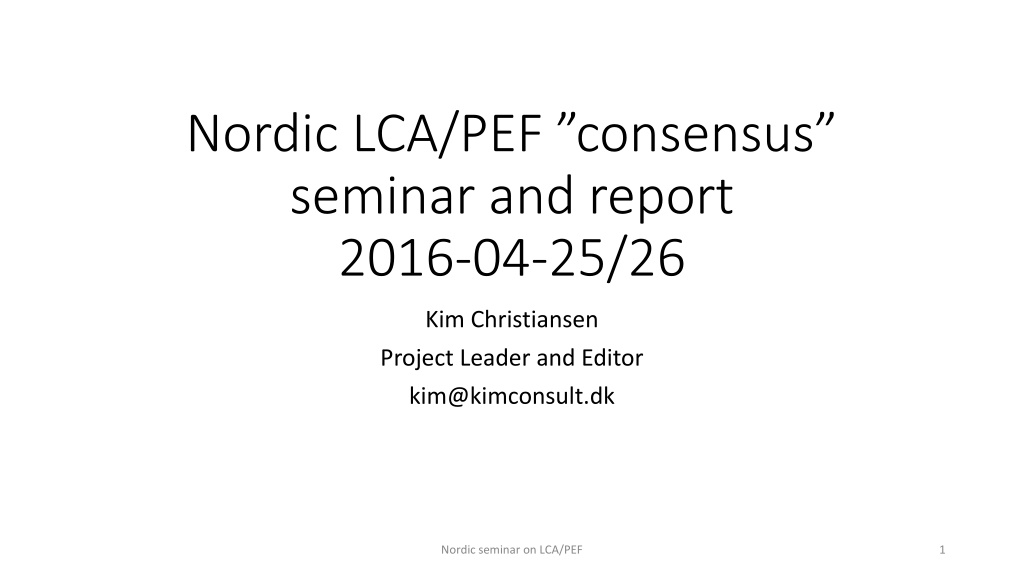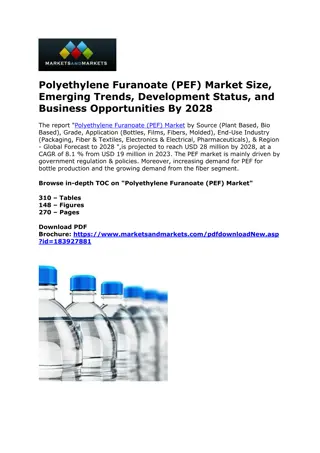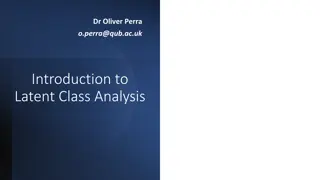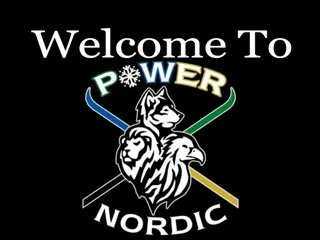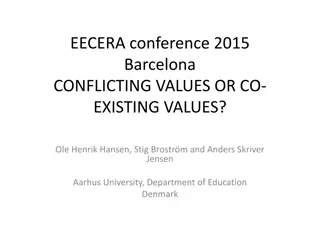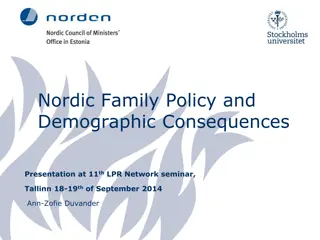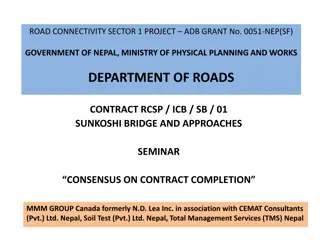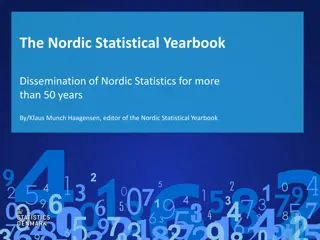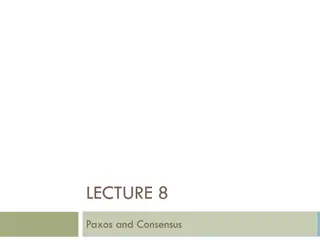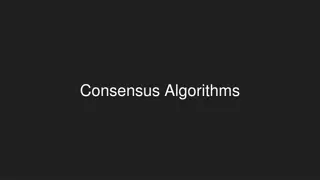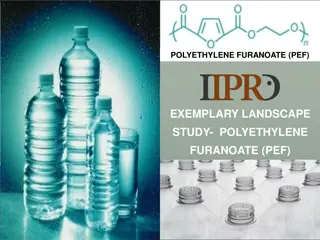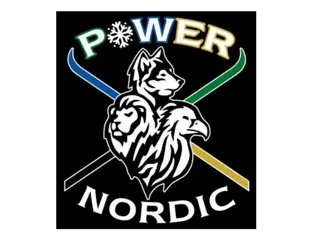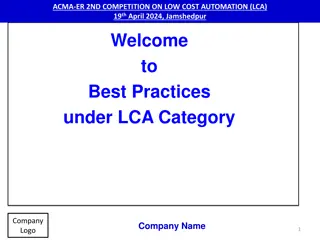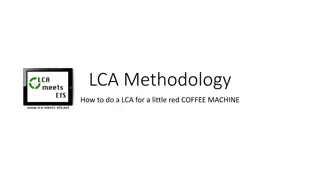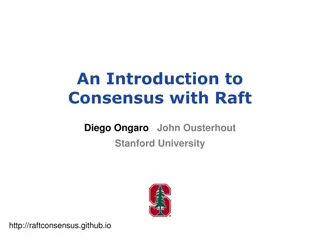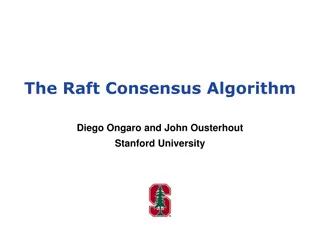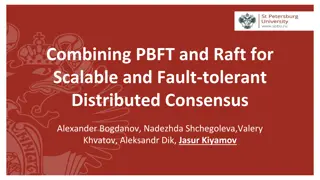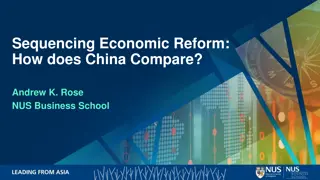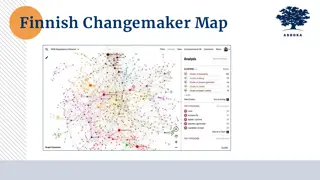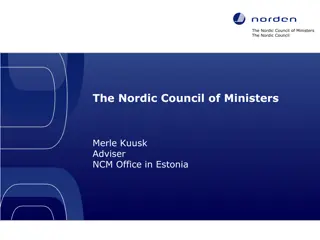Nordic LCA/PEF Consensus Seminar and Report 2016: Insights and Progress
Nordic Environmental Footprint Group (NEF) is a key Nordic authority cooperation group under the Nordic Council of Ministers dedicated to discussing and exchanging viewpoints on EU Commission testing and uses of Product and Organizational Environmental Footprint. Through workshops and seminars, NEF aims to enhance Nordic participation in relevant committees, contribute to the dissemination of environmental footprint concepts, and facilitate consensus-building. The project history highlights significant milestones in environmental sustainability initiatives in the Nordic region, culminating in the focus on key issues related to the EU Product Environmental Footprint (PEF) method in the 2016 Nordic LCA consensus workshop.
- Nordic Council of Ministers
- Environmental Footprint Group
- LCA/PEF
- Sustainability Initiatives
- Environmental Workshop
Download Presentation

Please find below an Image/Link to download the presentation.
The content on the website is provided AS IS for your information and personal use only. It may not be sold, licensed, or shared on other websites without obtaining consent from the author. Download presentation by click this link. If you encounter any issues during the download, it is possible that the publisher has removed the file from their server.
E N D
Presentation Transcript
Nordic LCA/PEF consensus seminar and report 2016-04-25/26 Kim Christiansen Project Leader and Editor kim@kimconsult.dk Nordic seminar on LCA/PEF 1
Who is NEF? Nordic Environmental Footprint Group A Nordic authority cooperation group under Nordic Council of Ministers (NMR) from 2015 Objectives To discuss and exchange viewpoints regarding the EU Commission testing and further uses of Product and Organizational Environmental Footprint To prepare in common Nordic Participation in the Commission PEF and OEF Steering Committee and Technical Advisory Group meetings To contribute in dissemination of PEF and OEF to Nordic stakeholders Nordic workshop on EU PEF in Stockholm 2015.09.24 Nordic LCA consensus seminar in Copenhagen, 2016.04.25-26 2ndNordic workshop on EU PEF in Oslo 28 September 2016 www.nordic-pef.org Nordic seminar on LCA/PEF 2
Background example from DK Development of UMIP: Udvikling af Milj venlige Industriprodukter) (1996) a Danish 20 year old fairy-tale (EDIP: Environmental Design of Industrial Products) Conditions: A government dedicated to environmental protection A lot of money (then) A university research group, who was able to do the work Results: A strong and international recognized handbook/methodology (1150 pages) Later on, an LCA toolbox A non-happy environment of LCA experts with a lot of non-used knowledge and unanswered questions Non optimal consultant guidance to stakeholders of new methodology/tools Answer A consensus-seeking process Nordic seminar on LCA/PEF 3
Project history Nordic LCA guidelines and ISO cooperation in the 90 ties EU LCA methodology, ILCD (2005-), single market for green products (2010), a resource efficient Europa in 2020 (2011) and Product Environmental Footprint project (2013-2016) Nordic Environmental Footprint group as part of government cooperation in the Nordic Council of Ministers (2015-) Nordic seminar on LCA/PEF 4
Project details and objectives Nordic LCA consensus workshop 2016 focus on the EU PEF method 5 key issues derived from the EU PEF project Weighting What is the right granularity for PEFCRs End of life formula How to choose the right functional unit for food products How to address uncertainty in a feasible and implementable way Core Nordic LCA experts Networking and common understanding of needed solutions Nordic consensus report Nordic seminar on LCA/PEF 5
Project organisation Project coordinator: Kim Christiansen, kimconsult.dk Nordic experts group: Bo Weidema, 2.-0 LCA consultants (replacing Jannick Schmidt) Erik Svanes, Oestfoldforskning (replacing Cecilia Askham) Johanna Berlin, SP Technical Research Institute of Sweden Sirkka Koskela, SYKE/Finnish Environment Institute NEF project reference group: Elin Eriksson, IVL (assisted by Tomas Ekvall) John Erik Hermansen, Aarhus University (assisted by Preben Kristensen) Monika Lahti, Environmental Directorate of Norway Ari Nissinen, SYKE (assisted by Sirkka Koskela) Nordic seminar on LCA/PEF 6
Participation Countries 21 participants DK = 7 FI = 2 NO = 5 SE = 6 EC = 1 Affiliation 11 research institutes or universities 5 consultants 4 government directorates or agencies 2 EPD programme operators Nordic seminar on LCA/PEF 7
Layout of the report Each expert contribution in its own chapter General introduction kept short Very different chapter layouts by the experts kept their responsibility Summary chapter by the editor my responsibility Nordic seminar on LCA/PEF 8
The Commission project (NEF observation based on Nordic interviews) A fast track development of PEF/OEF guidance based on ILCD by few experts: Necessary process for having a method within a political life time but not a standardisation approach How to secure a multistakeholder involvement? 26 pilot projects: Many stakeholders involved directly or indirectly participation on a voluntary basis Technical Advisory Board: 1 pr. Country and 1 pr. TS Some national networks Result: An internationally strong methodology and tools A strong need for dissemination of the results Nordic seminar on LCA/PEF 9
The right functional unit for food products Erik Svanes, stfoldforskning Mass and volume still the predominant basis easy to understand for consumers and supported by the food sector Single component closer to reality: Amount of product equal to 1 kg of protein,1000 kcal, or 1 kg dry matter Nutrient density index: Not easy to understand or to agree upon nutritional experts needed Food quality complicated also nutritional quality Quality indirectly included in price and life time Weidema et al 2004 may be an option Nordic seminar on LCA/PEF 10
Granularity of scope Kim Christiansen, kimconsjult.dk Guidance: TS define the scope based on classification index Result: Very high variation in level of scope not easy to compare or use as modules Bedo: not enough to avoid too wide or to narrow scopes Swedish and Norwegian EPD schemes: Scope is an ungoing iteration classification only for description Weidema et al 2004 from the Danish consensus and methodology project is not used because it was difficult to understand Recommendation: Rewrite the relevant part of the guidance based on Weidema et al, the ISO 14025 principles and the ISO 14044 Amd coming up Multistakeholder involvement in the full process of each parts of the organisation combined with open consultations funding? Granularity in scope and impact assessment Nordic seminar on LCA/PEF 11
End-of-life formula Sirkka Koskela, SYKE Attributional based formula used in PEF, but consequential approach to energy recovery If important, any process or parameter shall be included according to ISO 14044, so you need to know anyway Not easy in practice, therefore rules of thumb, cut-off etc. e.g. how to divide burdens from virgin materials between recycled materials and recovered energy Include quality aspects both on inputs and outputs in the formula Divide energy recovery benefit by 2 Paper recycling advocates 50:50 Better guidance is required, which will happen in the future, but will it be based on cut-off rules, allocation or a system expansion method? And how to improve data quality? Nordic seminar on LCA/PEF 12
Uncertainty F. R yne and J. Berlin, SF Use the matrix presented in Annex 4.1. Same weight to each of the 6 DQRs use with caution Add mass balances and substance check to identify data gaps Decrease data uncertainty as far as possible especially in databases used by many Validate by using group of experts Focus on guidance for SME: Database linked to external quality check Use of one database vs use of as many as possible Nordic seminar on LCA/PEF 13
Valuation (normalisation and weighting) Bo Weidema, 2.-0 LCA consultants Damage assessment is the most logical choice for valuation for PEF, due to its focus on the direct trade-off objective (reduction of damage) use end-point categories but different views Minimise the uncertainty by choice modelling and market data Utility-weights should be applied to ensure that equal weight is given to the values of each individual Monetary valuation an option but not the only one Avoid normalization and targets as basis for valuation when possible Use ecopoints, QALY s, or Euros as appropriate for the target group Nordic seminar on LCA/PEF 14
Overall project conclusions Collaboration if funded No Nordic consensus on all LCA issues Willingness to cooperate Technical seminars with plenary and ad hoc group discussions are good for mutual understanding Networking as important as the written outcomes The network can help in the implementation of PEF and OEF in the Nordic region Nordic seminar on LCA/PEF 15
Next steps The report and slide presentations are available at www.Nordic-pef.org The NEF group will consider the need for supporting future Nordic LCA expert dialog regarding PEF Nordic seminar on LCA/PEF 16
